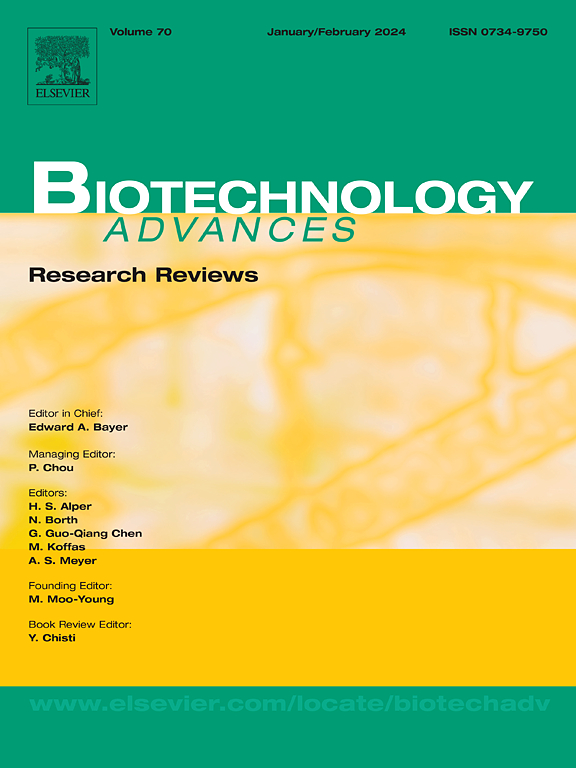Advances in gene editing-led route for hybrid breeding in crops
IF 12.1
1区 工程技术
Q1 BIOTECHNOLOGY & APPLIED MICROBIOLOGY
引用次数: 0
Abstract
With the global demand for sustainable agriculture on the rise, RNA-guided nuclease technology offers transformative applications in crop breeding. Traditional hybrid breeding methods, like three-line and two-line systems, are often labor-intensive, transgenic, and economically burdensome. While chemical mutagens facilitate these systems, they not only generate weak alleles but also produce strong alleles that induce permanent sterility through random mutagenesis. In contrast, RNA-guided nuclease system, such as clustered regularly interspaced short palindromic repeats (CRISPR)- associated protein (Cas) system, facilitates more efficient hybrid production by inducing male sterility through targeted genome modifications in male sterility genes, such as MS8, MS10, MS26, and MS45 which allows precise manipulation of pollen development or pollen abortion in various crops. Moreover, this approach allows haploid induction for the rapid generation of recombinant and homozygous lines from hybrid parents by editing essential genes, like CENH3, MTL/NLD/PLA, and DMP, resulting in high-yield, transgene-free hybrids. Additionally, this system supports synthetic apomixis induction by employing the MiMe (Mitosis instead of Meiosis) strategy, coupled with parthenogenesis in hybrid plants, to create heterozygous lines and retain hybrid vigor in subsequent generations. RNA-guided nuclease-induced synthetic apomixis also enables genome stacking for autopolyploid progressive heterosis via clonal gamete production for trait maintenance to enhance crop adaptability without compromising yield. Additionally, CRISPR-Cas-mediated de novo domestication of wild relatives, along with recent advances to circumvent tissue culture- recalcitrance and -dependency through heterologous expression of morphogenic regulators, holds great promise for incorporating diversity-enriched germplasm into the breeding programs. These approaches aim to generate elite hybrids adapted to dynamic environments and address the anticipated challenges of food insecurity.
以基因编辑为主导的农作物杂交育种之路的进展
随着全球对可持续农业的需求不断上升,rna引导核酸酶技术在作物育种中提供了变革性的应用。传统的杂交育种方法,如三系和两系系统,往往是劳动密集型的,转基因的,经济上负担沉重。虽然化学诱变剂促进了这些系统,但它们不仅产生弱等位基因,而且还产生强等位基因,通过随机诱变诱导永久不育。相比之下,rna引导的核酸酶系统,如聚集规律间隔短回传重复序列(CRISPR)相关蛋白(Cas)系统,通过对雄性不育基因(如MS8、MS10、MS26和MS45)进行有针对性的基因组修饰,诱导雄性不育,从而可以精确地操纵各种作物的花粉发育或花粉败育,从而促进更有效的杂交生产。此外,该方法允许单倍体诱导,通过编辑必需基因(如CENH3、MTL/NLD/PLA和DMP),从杂交亲本快速产生重组和纯合子系,从而获得高产、无转基因的杂种。此外,该系统采用MiMe(有丝分裂而不是减数分裂)策略,结合杂交植物的孤雌生殖,支持合成无融合诱导,从而产生杂合子系,并在后代中保持杂交活力。rna引导的核酸酶诱导的合成无融合也可以通过克隆配子产生来实现自多倍体渐进式杂种优势的基因组堆叠,以维持性状,提高作物的适应性,而不影响产量。此外,crispr - cas介导的野生近缘种的重新驯化,以及最近通过异种表达形态发生调节因子来规避组织培养抗性和依赖性的进展,为将多样性丰富的种质纳入育种计划带来了巨大的希望。这些方法旨在培育适应动态环境的优良杂交品种,并应对粮食不安全的预期挑战。
本文章由计算机程序翻译,如有差异,请以英文原文为准。
求助全文
约1分钟内获得全文
求助全文
来源期刊

Biotechnology advances
工程技术-生物工程与应用微生物
CiteScore
25.50
自引率
2.50%
发文量
167
审稿时长
37 days
期刊介绍:
Biotechnology Advances is a comprehensive review journal that covers all aspects of the multidisciplinary field of biotechnology. The journal focuses on biotechnology principles and their applications in various industries, agriculture, medicine, environmental concerns, and regulatory issues. It publishes authoritative articles that highlight current developments and future trends in the field of biotechnology. The journal invites submissions of manuscripts that are relevant and appropriate. It targets a wide audience, including scientists, engineers, students, instructors, researchers, practitioners, managers, governments, and other stakeholders in the field. Additionally, special issues are published based on selected presentations from recent relevant conferences in collaboration with the organizations hosting those conferences.
 求助内容:
求助内容: 应助结果提醒方式:
应助结果提醒方式:


